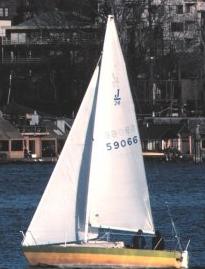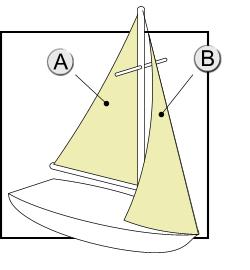Sloop
|
|
Important notice: This article is about the modern civilian boat type. For the warships of the 1800s to World War II, see Sloop-of-war.
In sailing, a sloop is a vessel with a single mast on which is hoisted a fore-and-aft rigged mainsail and a single jib, plus extras such as a spinnaker.
The name sloop has several other historical meanings, see below.
A marconi sloop is the optimal rig for upwind sailing, and consequently sloops are very popular with amateur sailors and yachtsmen, and for racing. The rig is simple—at least in its basic form—yet, when tuned properly, maneuverable and fast. Its main disadvantage is the large size of the sails on larger vessels. It is also less successful sailing downwind; The addition of a spinnaker is necessary for reasonable downwind speed in all but the strongest winds, and the spinnaker is an intrinsically unstable sail requiring continual trimming.
| Contents |
Rationale behind the sloop rig
When attempting to build an efficient ship, an important consideration must be kept in mind. This is the question of whether the ship will need to sail predominantly down-wind (i.e. with the wind behind the boat) or up-wind (with the wind blowing into the boat from the prow). Sloop rigs are specifically designed to optimise upwind sailing.
It is, however, clear that the most difficult direction to sail a (sailing) ship is upwind. Sailing to windward (known as sailing close-hauled) requires some specific design features. Firstly, to make a good upwind sailing ship, the sail must be as vertical as possible to maximise the wind's energy in the sails.
Two forces act on a sailing ship to deviate it from vertical. Firstly, the weight of the rig itself will tend to pull the sailboat over in one direction the moment the ship departs from the vertical. Secondly, the force of the wind acting on the sails makes the mast behave like a lever. The first effect can be counteracted by reducing the weight of the rig itself. Therefore, the sloop rig weighs quite a bit less than other rigs because its simple design requires fewer ropes and sails.
In terms of counteracting the shear introduced by the wind blowing against the sails, a keel is attached to the hull of the boat. A particular sail-plan will have an optimal set of keel shapes and sizes which will reduce the effect of the wind.
When sailing upwind, it is also important to minimize the drag of the wind on the sail and rig. A major cause of drag of the sail is a vortex of turbulent air generated by the top of the mast and sail. Secondary causes are non-optimal aerodynamic shapes of masts, stays and control lines. The sloop minimizes the tip-vortex's drag by making the sail high and narrow, maximizing the amount of sail for the same sized tip-vortex compared to a square-rigged or gaff-rigged ship. Also, the simplicity of the rig reduces the drag induced by control lines, masts and booms.
Sails carried
To maximize the amount of sail carried, the classical sloop may use a bowsprit, which is essentially a fixed boom that projects from the front of the boat. For downwind sailing, the staysail may be replaced (or sometimes supplemented) by a spinnaker or gennaker of larger sail area. The jib foresail, which does not overlap the mast, may be replaced by a genoa jib, which overlaps the mast by up to 50%, the mainsail and Genoa thus forming an efficient double wing.
History
The term sloop referred to boats with different rigs and up to 3 masts until the 17th century.
Sloops in their modern form were developed by the French to run British blockades. They were later adapted to pilot boats (small ships that take a pilot out to a ship to guide it into a harbor). Later still, they were adapted to smaller revenue cutters.
In the 1920s, racing sloops were developed into extremes in the amount of sail they would carry. The "J-boats" became infamous for capsizing, although in good weather they were very fast. These excesses led racing authorities to establish rules for racing yachts, intended to make them fully seaworthy. The first modern sloops were called "Marconi rigs" because their tall masts and complex standing rigging reminded people of Guglielmo Marconi's new wireless (radio) transmission antennas.
The state of the art in racing sloops today may be seen in the IACC yachts sailed in the America's Cup competition. This statement is only true in that the most money has been spent in this class, to build the fastest boats that meet the IACC rule. Much faster sloops have been built that don't fit the rule, using such forbidden technology as canting keels and movable water ballast.
The largest sloop ever built is the Mirabella V, with a carbon-fibre mast that is 289 ft/90 m high.
See also
- Corvette, a warship with this sailplan.
- Bermuda rig, also called a Marconi rig, the most common of the sloop rigs.


